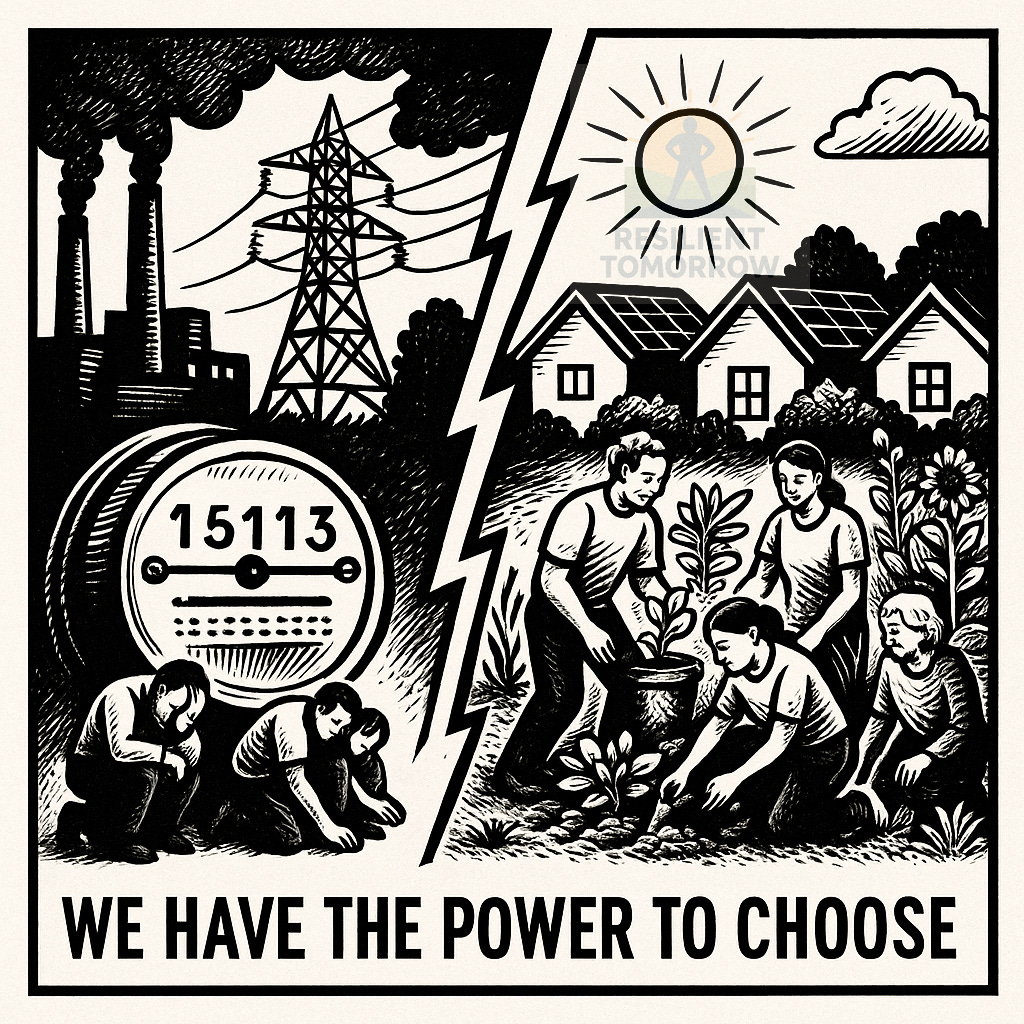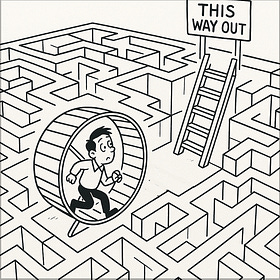What Happens When Neighbors Build Their Own Power Grid
Rising bills aren’t the end of the story. They’re the beginning of a movement to build what private equity can’t own, buy, or sell.
My neighbor just got their annual “true-up” bill from PG&E: over $2,000. They have solar panels. They generate clean energy. Yet thanks to California’s new NEM 3.0 rules, utilities buy that solar at wholesale rates and sell it back at retail. The house makes the power, the utility takes the profit.
And it isn’t just California. Across the Northeast, families are seeing delivery fees spike by hundreds of dollars. Meanwhile, BlackRock and Blackstone—the same private equity giants who turned housing into an investment scheme—are buying up utilities nationwide. As I wrote in Your Neighborhood is Being Sold While You Sleep, this is the next company town: not just your rent, not just your job, not just where you shop, but now your electric bill too.
They own the power. We pay whatever they demand.
That’s when I decided: enough. I posted in our local “Being Neighborly” group (yes, on Facebook, the platform I love to hate) asking if anyone wanted to learn how to build a solar backup system together. Five neighbors raised their hands. Frustration turned into a project. A question became a blueprint for independence.
This isn't just about lowering bills or keeping the lights on when the grid fails. It's about reclaiming control over one of the most basic necessities of modern life. And it touches every aspect of what we discuss here at Resilient Tomorrow: electricity, wealth, community building, knowledge sharing, communication, narrative, and even food (since power runs greenhouses, refrigeration, and off-season growing)—all seven systems from 7 Steps to Quietly Exit a System That Wants You Dependent.
I'll be documenting every step in a subscriber-only Power Playbook—from sourcing and buying the parts, to installation, and to the steps to evaluating and forming a neighborhood energy cooperative. Because if we can do this, so can you.
The Perfect Storm is Already Here
Energy analyst Matt Randolph—known as Mr. Global—recently broke down exactly why bills are exploding. Natural gas, which powers much of America's electricity, is projected to jump from ~$3.20 today to over $5 by 2026. That's a 40% increase hitting your bill directly, driven largely by short-term policies that prioritize exporting record amounts of natural gas to Europe over domestic energy stability—corporate profits over American households.
But it gets worse. Aging infrastructure nationwide requires massive upgrades—from Texas's failing winter grid to California's wildfire-sparking power lines—and guess who's paying? Not the utility companies making record profits while the grid crumbles. You are. Every transmission line, every grid repair, every "modernization" project gets passed straight to ratepayers.
And the policy landscape? Federal rebates for renewable energy are available in 2025, but unlikely to survive given the current administration. Tariffs on Canada, Mexico, and China will raise prices on everything from panels to inverters to household electronics.
This is the window. Right now. Before costs climb higher and incentives disappear.
Starting With What We Had
This isn't my first resilience project. I've already built rainwater catchment and started a greenhouse in my backyard—but electricity was the missing piece. I bought a Jackery 1000 v2 with portable solar panel as short-term backup, but I knew we needed to think bigger.
So I started where every good neighborhood project starts: with a conversation.
I pulled together everything I'd researched—my utility providers usage tools, the Google Project Sunroof calculator, my draft DIY backup plan—and sent it to my neighbors who had volunteered to participate. I made clear this wasn't just about saving money. It was about:
Reducing dependence on fragile systems
Learning skills together
Documenting the process so others could follow
The group said yes. We're in.
The Plan: From Frustration to Blueprint
Here’s what we’re building—not as isolated households, but as a neighborhood:
DIY over debt: Professional installs in our area run $40,000+. We’re targeting $10,000–$18,000 per household with battery backup—enough to consider going off-grid if needed.
Smarter sourcing: Instead of shiny retail panels, we’re buying used commercial panels with a decade of life left, or last-generation overstock with 25-year warranties. Quality gear, without the markup.
Flexible storage: We’re exploring hot-swappable battery packs that could be shared during outages—or full systems that can expand over time. Either way, it’s about resilience, not just backup.
Radical transparency: We’ll document every step—every purchase, mistake, and workaround—so anyone can replicate this, even if they’ve never touched a panel before.
All the gritty details—suppliers, pricing, wiring diagrams—will live in the Power Playbook, available for paid subscribers. That’s where this turns from story into step-by-step guide.
Why This Matters Beyond Power Bills
This project isn’t about shaving a few dollars off the electric bill. It’s about shifting who holds the power—literally and figuratively.
Every kilowatt we generate is one we don’t buy from utilities designed to profit off dependency. Every panel and battery we install becomes part of a shared defense system. If one house falters, others can step in.
This is resilience in practice:
Electricity becomes independence.
Wealth becomes access, not just dollars.
Community becomes infrastructure.
Knowledge becomes insurance against future crises.
Communication becomes possible, even in blackouts.
Narrative becomes a new story of what’s possible.
Food even gets touched indirectly—because power runs greenhouses, refrigeration, and off-season growing.
This isn’t a personal upgrade. It’s a neighborhood experiment. We don’t wait for collapse—we build something better. Our neighborhoods create what private equity can’t buy, sell, or own.
What Comes Next: Energy Cooperative
If this works, it becomes the blueprint for a neighborhood energy cooperative—solar infrastructure owned collectively by residents, maintained within the community, with any profits from selling excess energy back to the grid either reinvested in upgrades or redistributed among members.
Think community garden, but for electricity.
I'll be documenting the entire process of exploring and potentially forming this cooperative in the Power Playbook. Legal structures. Financing models. Maintenance protocols. Conflict resolution. Everything you'd need to replicate this in your own neighborhood.
Your Turn
We’re proving that resilience doesn’t require permission. Every kilowatt we generate is one less dollar handed to utilities making record profits while the grid crumbles. Every battery installed is backup power for the block. Every neighbor who learns to troubleshoot becomes part of our defense network.
This is exactly what I wrote in The Game Was Rigged: the system is designed to keep us dependent. In Stop Waiting for Heroes, I argued we can’t wait for top-down solutions. And in The Imagination Heist, I showed how change begins the moment we can picture it differently.
This project is all three, in action. We’re not waiting. We’re building. And we’re doing it together.
Now it’s your turn.
Subscribe to get each update as we build—and access the step-by-step Solar Power Playbook, with every mistake, fix, and breakthrough documented.
Share this with a neighbor who’s tired of waiting for someone else to fix the system.
Comment with what you’re already building, or what you want to start. Solar may not fit where you live—so tell us what you’re exploring: wind, micro-hydro, geothermal, or battery-only backups. I’ll add these to the Playbook so we can learn together.
Organize: Ready to start your own group? Drop your location in the comments. Let’s connect neighbors ready to stop paying whatever utilities demand and start building what we actually need.
This isn't just about surviving rate hikes and blackouts. It's about proving that when we stop waiting and start building, we don't just keep the lights on—we illuminate a future worth living in.
Subscribe for free to get practical solutions for building resilience in your neighborhood, or upgrade to paid to follow along with the solar project as it develops and get access to the Community Defense Playbook, plus each step of the Power Playbook as it's implemented, including a final complete copy once the project is completed.
P.S. This project reminded me how frustrating it is to depend on Facebook to connect with neighbors. We need better ways to organize locally without feeding the surveillance machine. Quick question: If you had access to a community platform that didn't collect your data and gave you ownership of it instead, would you be willing to use it for neighborhood organizing? Let me know in the comments—I'm exploring building exactly that.
Previous Related Articles
7 Steps to Quietly Exit a System That Wants You Dependent
If you’ve ever thought, “This can’t be it,” you’re right.
Power to the People: Reclaiming Your Energy Sovereignty
Step 2 (article 4) in the “7 Steps to Quietly Exit a System That Wants You Dependent” Series
Stop Waiting for Heroes
Look around and you'll see a world waiting for saviors. Political messiahs promising to fix broken systems. Billionaire visionaries pledging to revolutionize our future. Some are even half-seriously hoping aliens might descend from the stars or rise from the oceans with advanced solutions to our earthly problems. While th…









Do it. We live off grid and have invited others to join us
This is giving me hope, but I also feel left behind because I rent an apartment with zero outside space. Is there any hope for renters?